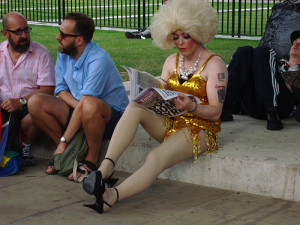 Listed below is a selection of my writings on gender and sexuality, dating from the 1970s to the present. If you are interested in something I’ve written that doesn’t appear here, please let me know and I will try to help. Links to groups, activists and researchers in related areas can be found in Links and Resources.
Listed below is a selection of my writings on gender and sexuality, dating from the 1970s to the present. If you are interested in something I’ve written that doesn’t appear here, please let me know and I will try to help. Links to groups, activists and researchers in related areas can be found in Links and Resources.
The question is not whether there is a true inner sexuality to be liberated, but which ways of understanding ourselves make it possible to act with some chance of bringing about positive changes. ↩ 1997
2024. When British poet and aphorist Elizabeth Gibson Cheyne described herself in ‘Who’s Who’ as a suffragist, socialist and freethinker, she was actively constructing a public identity not just as a writer, but as an activist. But identities can’t be so neatly categorised and controlled. Paper given at the Womens’ History Network annual conference.
2011. How are ideas of sexual and political dangerousness connected? How can we challenge the polarization between academics and activists, theory and practice, and find new ways of propagating ideas?
Preface to Anarchism and Sexuality: Ethics, Relationships and Power, eds. Jamie Heckert and Richard Cleminson.
2010. Gendered approaches to anarchist history can generate new ideas about anarchism past, present and future.
Paper given at PSA conference, Edinburgh, 2010.
2009. Anarchists and others debate free love in theory and practice. What is the relationship between sexual freedom and social transformation?
Chapter from Laurence Davis and Ruth Kinna, eds, Anarchism and Utopianism.
2009. Anarchism, homosexuality and sexual politics in the late nineteenth and early twentieth century. Review article from Anarchist Studies, 17:1.
2008. Researching an unknown relative, poet and feminist Elizabeth Gibson, raised tricky questions of methodology as well as the challenges of combining family history and academic research. Article from Qualitative Research, 2008:8.
2005. Discusses links between sexual and political outlaws. Review article from Anarchist Studies 13:1.
2004. Discusses the close relationship between the sibling poets, and the influences on their artistic and political development. Article from Dymock Poets and Friends, No.3.
2003. How did ideas about free love and sexual liberation change among anarchists and libertarians between the 1880s and the 1970s? Paper given at Past and Present of Radical Sexual Politics, Amsterdam.
2002. How do the realistic and practical, the utopian and impossible, become polarised? And what difference does gender make? Discusses women’s fictional and non-fictional accounts of utopian experiments in 1890s England. Article from Geografisker Annaler 84 B.
2002. Joan Crawford meets utopian theory in the outlaw territory of the Temporary Autonomous Zone, in this discussion of the film ‘Johnny Guitar’. Article from Altitude, Vol.2, Article1.
1998. ‘How can one classify and label the different kinds of love?’ Discusses how fin-de-siècle feminists and sexual radicals creatively reinterpreted Weininger’s misogynist theories to challenge restrictive categories of sex and gender. Chapter from Sexology in Culture: Labelling Bodies and Desires, eds. Lucy Bland and Laura Doan.
1997. Do new technologies and new theories of sex, gender, and the body pose a real challenge to existing power relationships? Chapter from Twenty-first Century Anarchism: Unorthodox Ideas for a New Millennium, eds. Jon Purkis and James Bowen.
1993. Problems and tensions between men and women in utopian communities are nothing new, especially when it comes to sharing the housework. Chapter from Diggers and Dreamers 94/95, eds. Chris Coates, Jonathan How, Lee Jones, William Morris, and Andy Wood.
1977. Challenges divisions between the Gay and Women’s Liberation movements, and the indifference of the left, in the context of a violent anti-gay backlash. Article co-authored with Margot Farnham, from Zero 3, October/November 1977.
1975. ‘The Women’s Liberation Movement has made it possible to share and begin to analyse experiences and feelings usually kept private.’ Article from Wildcat No.6, March 1975.